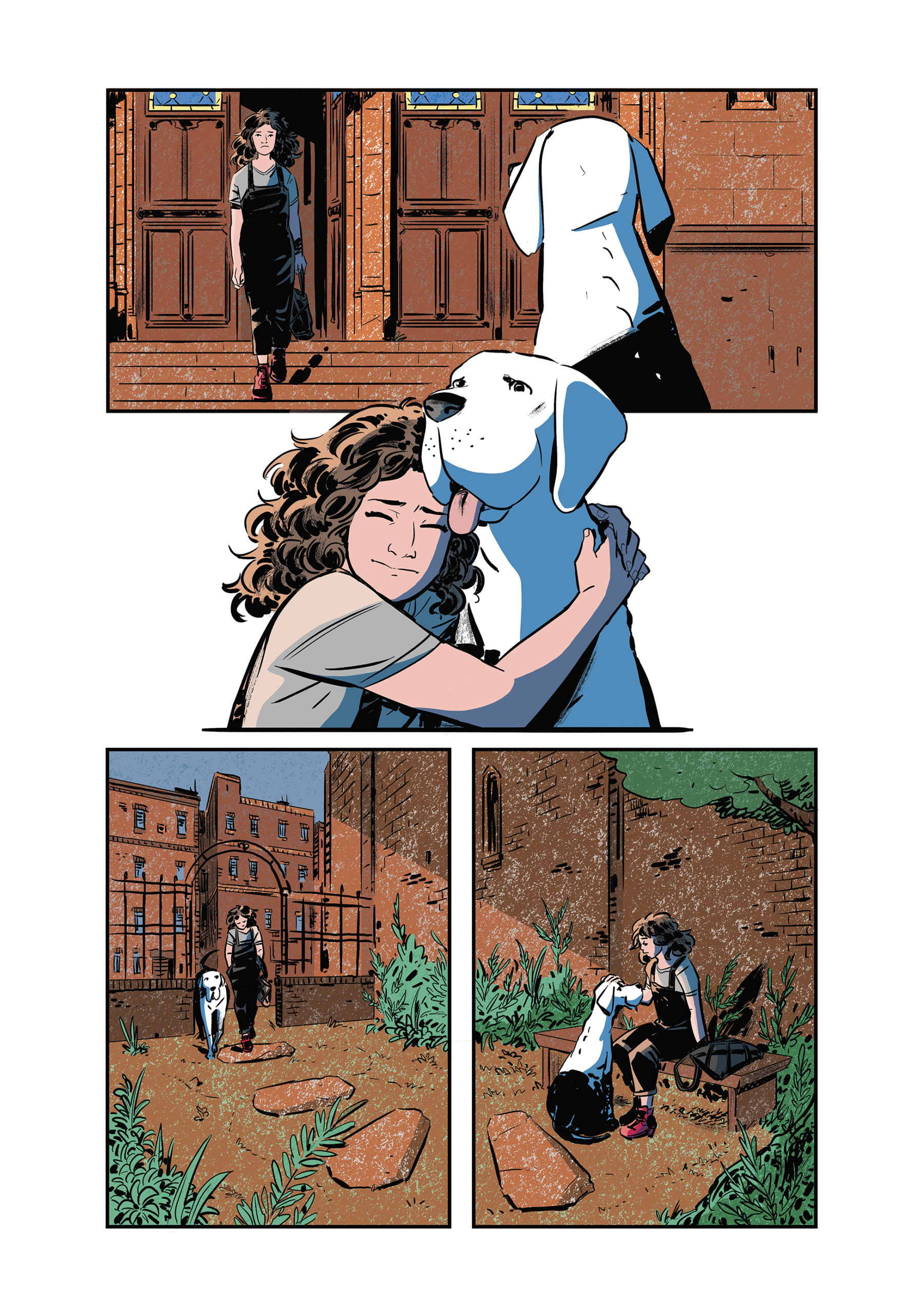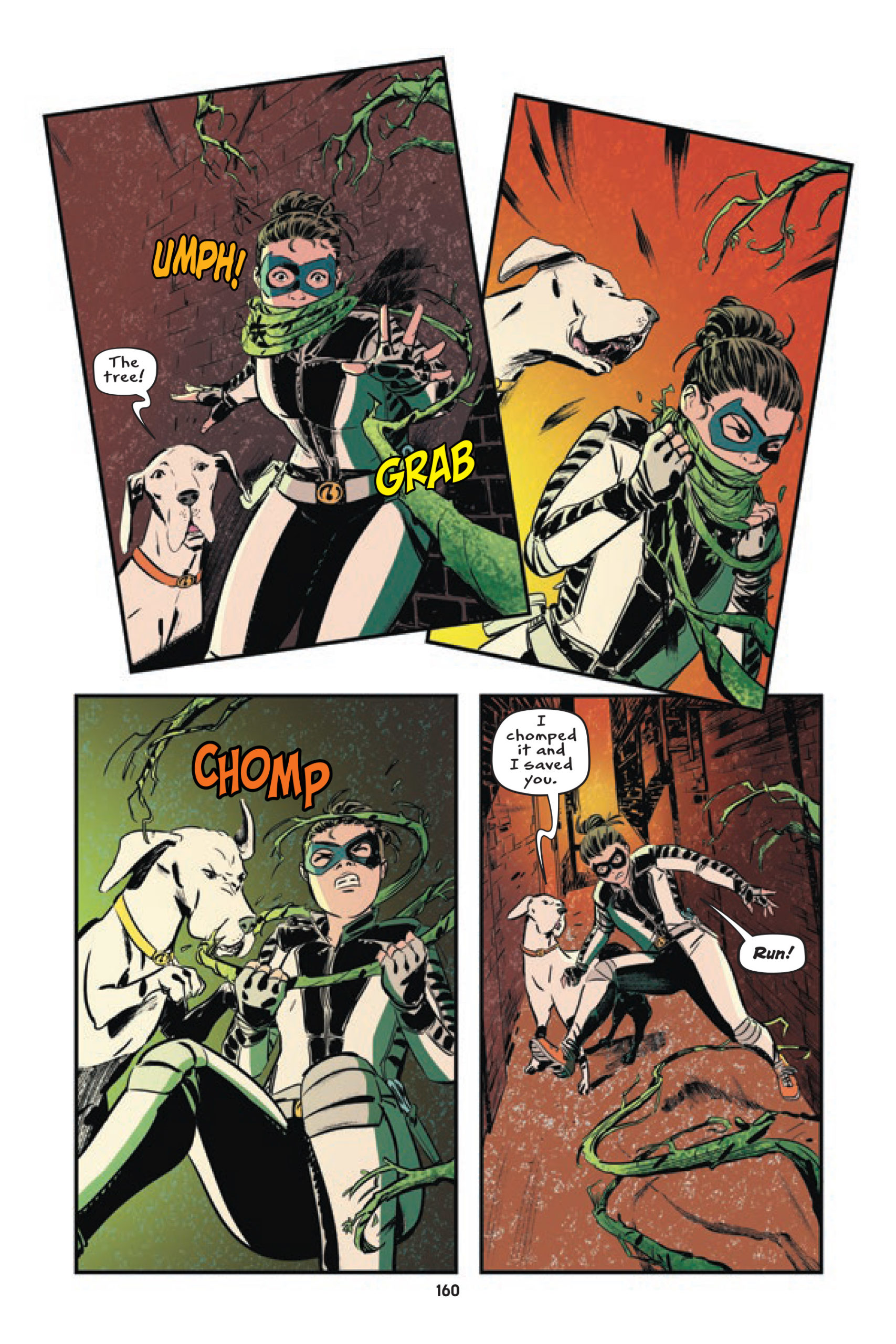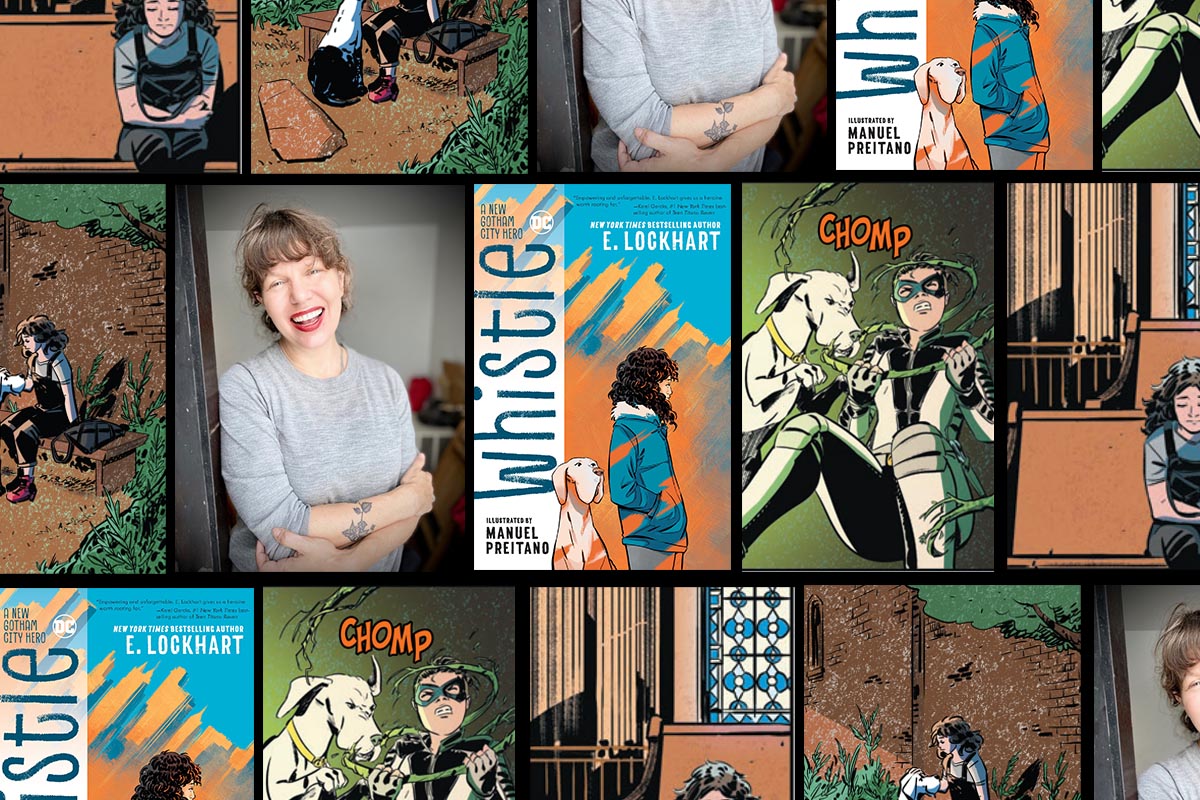Willow Zimmerman is 16 years old. She cares deeply about her neighborhood, Down River in Gotham, and is worried about her mom, who is getting sicker and sicker with each passing day. Searching for help, Willow turns to her mom’s old friend E. Nigma, who offers Willow a job running his private poker nights. But, one night, Willow and her dog Lebowitz (as in Fran) are attacked by Killer Croc — and when they wake, they realize they can understand each other. Oh, and Willow’s Jewish — and proud to be Jewish. And yes, you are going to be completely in love with her.
Willow makes her debut in “Whistle,” a new DC Comic by E. Lockhart out on September 7. Ahead of the release, Lockhart chatted with Alma about all things “Whistle,” Jewish representation, comic books and her dream movie adaptation.
This interview has been lightly edited and condensed for clarity.
Can you tell me about the process behind creating a new superhero?
DC invited me to do it! That was the real stimulus. I had been talking to them about writing for them for a while, and they invited me to come and visit their archives. I have a doctorate in English, and did my dissertation on book history, so I am a sucker for an archive full of rare editions. I think they give this tour to everyone they’re flirting with, but it worked really well on me, to have this wonderful hour-long tour of the DC archive — which is full of original art, first editions and movie memorabilia. They give you a quick history of any character that you’re interested in; they show you their first iterations and unique variations on the character. It was such a wonderful invitation to write something, so I wrote a proposal which they accepted. I knew I was going to use some of those Batman villains.
And then I thought about what kind of hero I would most like to see, and also what I could bring to the table. There’s such a long history of amazing, creative things that have been written in Gotham Cities, and movies that have been made, and all of that — so what what could I bring that hadn’t already been done? I thought that I could bring a very relatable kid — like a lot of the kids I know in New York City — and give her superpowers.
Why was it important to you to make Willow Jewish?
My father is Jewish, my spouse is Jewish. My mother practices a New Age religion. My Jewish heritage, I [understand it] in a mostly secular way. But the Jewish heritage of my dad’s side of the family — people coming over from Russia and [Eastern Europe] at the turn of the century, and living in Manhattan and the Bronx — this was something that I had always grown up with as a very important part of my identity. So I thought about creating a heroine whose heritage is important to her the same way, and creating a neighborhood in Gotham that is parallel to New York City’s Lower East Side — which has a long and amazing Jewish history. I was really excited by bringing some elements of the history of New York into Gotham City, and in creating an activist heroine who was a combination of some traits of my own kids and other teenagers that I knew living in Brooklyn.
What was it like to create a Jewish neighborhood in Gotham?
It was so fun! I started with actual landmarks that I know and love. People who know the Lower East Side will pretty easily recognize that the Rosen Brothers Delicatessen is a fusion of Katz’s Deli and the Second Avenue Deli. Shelsky’s Bagels of Gotham is where there’s a big battle scene in the book — Shelsky’s is actually a new Brooklyn based appetizing shop that I love, and I go to all the time. So I borrowed Shelsky’s name, even though it’s not really a Lower East Side institution, just as a shout out to one of my favorite places to buy a good Reuben.
There’s a synagogue that I’ve toured — Museum of Eldridge Street — so some of the visuals of the synagogue that show up in Down River Gotham City are based on pictures I sent to the illustrator of the Eldridge Street Synagogue. That’s where I started, and I gave my heroine a mom who is professor of Jewish history — that gives her a reason to know a little more about the history of this awesome neighborhood than she might otherwise.
I also love that her superpower is tied with her dog. Are you a dog person yourself?
I am not a dog owner, I don’t have dogs, but I write about dogs all the time. I find them very fascinating in their open-heartedness and their lack of inhibitions. The idea of a teenage girl whose body is changing — I mean, all teenage girls and boys, their bodies change, this is one of the fundamental things about writing about young adulthood: Your body is doing stuff that is unfamiliar to you, and you have to navigate that.
Superhero stories [are] the story of a body that’s changing when you become a superhero; your body changes in really empowering ways that might be even more upsetting or intimidating than adolescence. And then you have a dog companion, and a mind-meld with a dog. To have a companion, or a best friend, who is completely comfortable in their body — who thinks their body is awesome, who is completely free of shame, who just delights in the body — that was something that I really loved about the idea of this talking dog superhero: her openness.

I love that the dog is named Lebowitz, after Fran. Did you consider any other names, or was she always named after Fran Lebowitz?
She had another name, but it’s been Lebowitz for a very long time. I started loving Fran Lebowitz’s writing in my 20s, and I just found her essays — some are dated now but that doesn’t diminish her extreme wit and self-possession. Fran Lebowitz is utterly herself in a way that I admire hugely, without compromise and without apology.
If Fran Lebowitz ever read “Whistle,” what do you think she’d think of it?
[Laughs] I would be very frightened to hear anything Fran Lebowitz had to say about anything I wrote.
What other adventures do you foresee for Willow?
Oh, I hope she has many adventures. But I don’t know exactly. I would like to get my hands on the Penguin and Harley Quinn, and many other Gotham City villains. I have some ideas for who she’d encounter next, what they might be up to, but future plans are not clear yet.
How does that work, out of curiosity? When you wanted to do this story with the Riddler and Poison Ivy, are those characters that are offered to you or do you say, “I want them to be in my story”? What’s that process like?
They just said I could [use] whoever I wanted.
Oh, very cool.
I was free from DC continuity, so I could take those existing villains and make of them what I wanted. They were very flexible. I think if I had been writing within DC continuity, then I would be needing to fully understand the history of these characters as they are operating in the comic books at present, in this particular universe. But because this was outside continuity, I could create an origin story for the Riddler that is different from the usual origin story, for example.
What was the process like of working with artist Manuel Preitano to bring your words to life? Did you always know Willow would have big curly hair? How did you share what you were imagining?
I was able to say a lot about how she would look. We shared a lot of Pinterest images, and if you go to my Pinterest page, you can see inspiration images for all the major characters — including the dog.
He did character sketches: design sketches for the different characters until they looked a way that I felt great about. We did a lot of costume design for the superhero costume as well. A lot of back and forth, figuring out what she would wear. There’s a great fun in superhero comics of the exaggerated hyper-muscular hyper-fit body, and I didn’t want to lose that fun, but at the same time, I wanted to depict a much more typical teenage girl body — with realistic proportions. We were trying to find a superhero costume that would look cool and be empowering and look superhero-y, and at the same time be relatable. So the people could say, “Oh, she looks like me,” or, “That could be me.” That’s an ordinary girl who has become a hero.

On that note of representation, a lot of the press around “Whistle” (including on Alma) touts it as the first new Jewish superhero in DC in over 40 years. What does that mean to you, to be bringing Jewish representation into comics like that?
I’m so lucky to have gotten to do this. DC has asked me to say this carefully, because DC has rebooted a number of important characters as Jewish who did not necessarily originate as Jewish. So if you start researching Jewish superheroes, you will come up with, for example, Batwoman and Green Lantern — who were not Jewish as originally written and originally invented, but when they reboot these characters, they can give new origin stories. That’s one of the wonderful things about these characters: They can have multiple existences and multiple parallel universes, or in the hands of a new writer, they can simply be reinvented.
So, Whistle is the first DC superhero — as opposed to a villain — who has originated as Jewish since 1977. Harley Quinn is Jewish, but she’s a villain; she originated in 1999. And she is officially Jewish, basically, because she was voiced by Arleen Sorkin, a Jewish comedian. Harley Quinn originated on TV, which is unusual for a comic book character, and Sorkin’s performance shaped the character from the get-go. So Harley is who shows up on DC’s Instagram at Hanukkah, as their most famous Jewish character. But she’s a bad guy! Recent movies notwithstanding.
What has the reception to Willow been like so far?
The younger sister of one of my kid’s friends was really curious to see the character, because her name is Willow. So I sent over some early pictures that Manuel Preitano had drawn of the character in costume and out of costume. And her mom texted me, nearly in tears, she said, because her daughter said, “She looks just like me.” And she doesn’t look just like her — but she felt like she could see herself in this character. It was not that the character looks like her so much, it was the character was a girl like her: a New York City girl, a Jewish girl, a girl of short stature. Just a girl who cares about stuff and is trying to make a difference. All the things that I just described are linked with Jewish identity of many people in my community, myself my kids.

On that note, are there Jewish comic books or other Jewish pop culture moments — be it TV or movies or novels — that have felt meaningful in their representation for you?
I grew up with a lot of really great Jewish children’s book writers. The most important for me was Sydney Taylor’s “All-of-a-Kind Family.” Those books are very, very important to me growing up. Also, Charlotte Zolotow and Maurice Sendak and Norma Klein and Judith Viorst and Judy Blume and Ezra Jack Keates… amazing creators of of books for young people. I was never without Jewish representation in my literature; those were all popular creators of books for children when I was growing up.
I got really excited about Jewish people and comic books from reading “The Amazing Adventures of Kavalier & Clay” by Michael Chabon, which I read when it first came out. That was my first introduction to the interrelationship of Jewish identity and comic book heroes, which is a very long, long history, and I started to understand how incredibly cool and complicated it is, and was, that most of our most iconic superheroes were invented by Jewish creators and can be read through a Jewish lens. And that’s true of Superman, Batman, Spider Man, and on and on.
It’s pretty remarkable. I feel like when I think of Jews and comic books — I went to sleepaway camp for many years, and my mom would always send me comic books. So I very much associate reading them at summer camp, but I think “Whistle” is the first comic book I’ve read in I don’t know how many years.
What did your mom send you?
My mom would send me the Archie comics.
Oh yeah, I read a lot of Archie.
I read a lot of Archie. I never really read the superheroes, really.
I would go with my Uncle Richie to this comic book store with my cousins, he would take us all on the weekend. He would buy superhero comics. We would buy — they were like 10 cents each, used comics that were in bins. We would go to the bins and get the Archie and Richie Rich and maybe Little Lulu and Scrooge McDuck. But mostly Archie, that was like, the thing you were looking for. We were given a couple bucks, but that would buy a big stack of comics. When we would go home, I would read through everything that I had gotten, and everything that my female cousin had gotten, and then I would read the superhero comics that my uncle and my boy cousin had gotten. I would just keep reading through those. That how I got introduced to Batman and the Fantastic Four and the X-Men and Incredible Hulk and all of that. So I really did read them a lot as a kid, and they were a huge part of my imagination. But it’s funny that I almost never spent my own 10 cents on them.
I feel like comic books are so big in pop culture right now because of all the movie adaptations. In a dream world where “Whistle” is getting adapted into a TV show or movie, what type of vision do you have for it?
Whistle is a local neighborhood superhero. She’s not saving the world, she’s saving her neighborhood — which isn’t to say that her superpower isn’t big enough, I think it is big enough to do some world-saving. But she is concerned with local issues and local politics and the people in her community. As we’ve learned with a deeper understanding of voting and local lawmaking, a very important part of making change is to make change at the local level. A lot of big things can be affected that way. All that is to say that, I guess in a movie world, it would be a very intimate, character-driven portrait of a girl and the neighborhood. I would dream of a filmmaker like Marielle Heller or Nicole Holofcener, someone like that, trying their hand at a superhero movie.
What was your ultimate goal in creating Willow?
Becoming a vigilante superhero is a really weird thing to do, right? We cannot think about this kind of thing with moral absolutism anymore. Maybe once upon a time we did, but we cannot anymore. It is messy. And, trying to be a good person in the world, and having conversations and having disagreements with other people about what it is to be a good person… that is part of my Jewish intellectual heritage that I really treasure. And that is something that I really tried to bring to this hero: It’s not an easy choice. It’s never an easy choice. There are split loyalties, people have good and bad in them. There are arguments to be had about what the best path forward is, and those arguments can go on forever without full resolution. The important thing about being a humble person is that you continually engage in those conversations and keep trying to figure it out. I was trying to create a hero whose position in the world is far from simple, and who is continually engaging that way.



